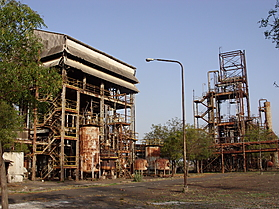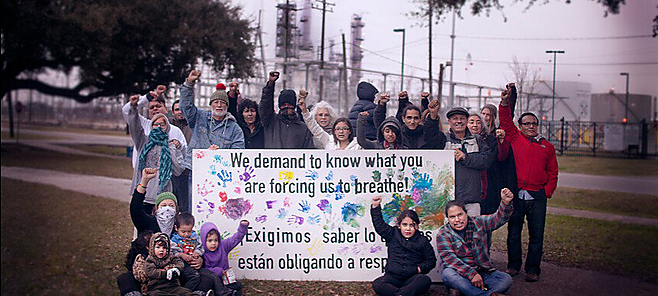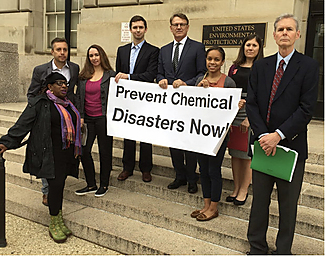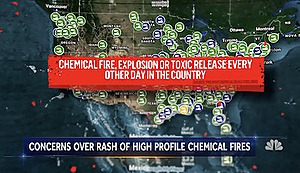The U.S. Environmental Protection Agency’s Risk Management Program (RMP) rule was created to prevent chemical disasters by regulating an estimated 11,700 facilities that use, store and manufacture large quantities of toxic and flammable chemicals. Facilities regulated under the RMP are required to submit risk management plans characterizing risks to facilities and measures to prevent chemical disasters.
For decades, members of our coalition have called on the EPA to strengthen this rule to protect workers and communities. Every year that stronger prevention measures are delayed, more chemical disasters occur, causing more injuries and deaths, and contaminating our communities’ air and water.
Learn more about our demands or jump down the page to our most recent advocacy work.
1984: Bhopal disaster at pesticide manufacturing plant kills thousands
 Thousands were killed and many more were injured when a pesticide manufacturing company owned by Union Carbide in Bhopal, India, released a poisonous gas into the surrounding community in the middle of the night. Families in Bhopal are still suffering profound intergenerational health impacts from the gas release and ongoing contamination today from this preventable disaster. Union Carbide’s own internal reports had warned of equipment failure, operating problems and maintenance problems at the facility, but these warnings were ignored by the company.
Thousands were killed and many more were injured when a pesticide manufacturing company owned by Union Carbide in Bhopal, India, released a poisonous gas into the surrounding community in the middle of the night. Families in Bhopal are still suffering profound intergenerational health impacts from the gas release and ongoing contamination today from this preventable disaster. Union Carbide’s own internal reports had warned of equipment failure, operating problems and maintenance problems at the facility, but these warnings were ignored by the company.
1990–1996: The Risk Management Program (RMP) is created to prevent the next Bhopal
In 1996, EPA established the Risk Management Program rule, as required by amendments to the Clean Air Act that were passed by Congress in 1990. The RMP requires facilities that store select toxic and flammable chemicals above certain thresholds to 1) prepare a history of “accidental releases” every five years 2) perform an analysis to determine what the consequences would be to the surrounding community should a worst-case incident occur, whic is called an Offsite Consequence Analysis (OCA), and 3) submit an emergency response plan to the EPA.
2013: West, Texas disaster destroys a neighborhood, prompting executive order. Our coalition demands stronger regulations to prevent future disasters.
On April 17, 2013, an ammonium nitrate explosion at a fertilizer plant in West, Texas killed fifteen people, including twelve first responders, injured over 250 people, and leveled an entire city block of over 150 buildings, including two schools and a nursing home. The chemical involved in the explosion, ammonium nitrate, was not covered by the Risk Management Program and did not have to plan for a potential chemical release. Unfortunately, this and many other hazardous chemicals are still not covered by the RMP today.
Spurred into action, the Obama-Biden administration directed the EPA to develop a new RMP rule months later. The Coalition to Prevent Chemical Disasters launched a website and released polling data showing that the majority of American voters supported federal requirements for chemical plants to switch to safer chemicals and processes. Watch the video short “President Obama: Prevent Chemical Disasters.”

2014: Report shows communities of color and low-income communities are disproportionately located near hazardous facilities: EJ communities mobilize
A new report “Who’s in Danger? Race, Poverty, and Chemical Disasters” showed that Black, Latino/a and low-income communities are disproportionately located in the vulnerability zones of hazardous facilities. The Environmental Justice Health Alliance for Chemical Policy Reform (EJHA) mobilized its 32 fenceline affiliate organizations in 12 states to participate in listening sessions held by the Obama Administration’s Interagency Working Group on Chemical Facility Safety and Security, demanding stronger protections for communities and workers. The Obama-appointed Interagency Working Group then released the report “Actions to Improve Chemical Facility Safety and Security – A Shared Commitment” endorsing many of our coalition demands.
2016: More than 40,000 people call for more preventative requirements after EPA proposes modest improvements to the RMP rule

Representatives of The Coalition to Prevent Chemical Disasters gathered at the EPA’s federal offices to present comments from over 125 organizations and 40,000 members of the public, calling for a stronger Chemical Disaster Rule. In a positive step, the EPA’s proposed rule mandated independent audits of RMP facilities that had reported a single incident. But the rule exempted 87% of RMP facilities from having to conduct a Safer Technology and Alternatives Assessment (STAA), and did not create a publicly accessible clearinghouse of safer available alternatives that could encourage and support the adoption of safer alternatives by more facilities.
2017–2019: Trump’s EPA delays and revokes improvements to RMP rule, as chemical disasters continue
Responding to industry pressure, the Trump administration illegally delayed implementation of the updated RMP rule for more than a year. In 2019, the EPA rolled back all of the Obama-Biden administration’s revisions to the Chemical Disaster Rule, prompting several groups in our coalition to sue the EPA.
In August 2017, power loss caused by flooding in the wake of Hurricane Harvey triggered a major chemical disaster at the Arkema Inc. chemical plant in Crosby, TX.
2021–2022: Our coalition begins tracking weekly chemical incidents as we call on the Biden-Harris administration to restore and strengthen RMP rule
Shortly after taking office, the Biden-Harris administration announced its commitment to an all-of-government approach to advance environmental justice. In 2021, the EPA announced its intention to update the Risk Management Plan rule. Our coalition began tracking and mapping hazardous chemical incidents sourced from news reports, and ramped up our campaign for stronger regulations to prevent chemical disasters.
A diverse group of stakeholders called on EPA to finalize the strongest possible chemical disaster rule, including members of Congress, local and state elected officials, chemical security experts, health professionals, faith leaders, labor unions and fenceline community members backed by environmental health and justice organizations.
In 2022, EPA Administrator Regan signed the Safer Communities by Chemical Accident Prevention (SCCAP) rule, which proposed revisions to the Risk Management Program that fell short of our demands. 100 organizations signed onto comments by our coalition, urging EPA to “fully satisfy the law and the agency’s core commitments on environmental justice, worker safety, and climate change.” Learn about our recommendations.
2023: East Palestine, Ohio disaster heightens national awareness of chemical dangers
 In February 2023, a train carrying toxic chemicals derailed in East Palestine, Ohio. The vinyl chloride that was later ignited in a “controlled release” in the community was being transported between hazardous facilities involved in the supply chain for PVC plastic. Facilities that store threshold amounts of vinyl chloride are covered by the RMP rule. Our coalition released data showing that hazardous chemical incidents are occurring every other day on average in the U.S., as reported in the Guardian and NBC Nightly News.
In February 2023, a train carrying toxic chemicals derailed in East Palestine, Ohio. The vinyl chloride that was later ignited in a “controlled release” in the community was being transported between hazardous facilities involved in the supply chain for PVC plastic. Facilities that store threshold amounts of vinyl chloride are covered by the RMP rule. Our coalition released data showing that hazardous chemical incidents are occurring every other day on average in the U.S., as reported in the Guardian and NBC Nightly News.
2024: EPA finalizes a stronger Risk Management Plan rule, incorporating several coalition recommendations.
See the final rule here, as well as press releases from coalition members BlueGreen Alliance, Coming Clean and EJHA, Earthjustice, New Jersey Work Environmental Council, and Union of Concerned Scientists.

